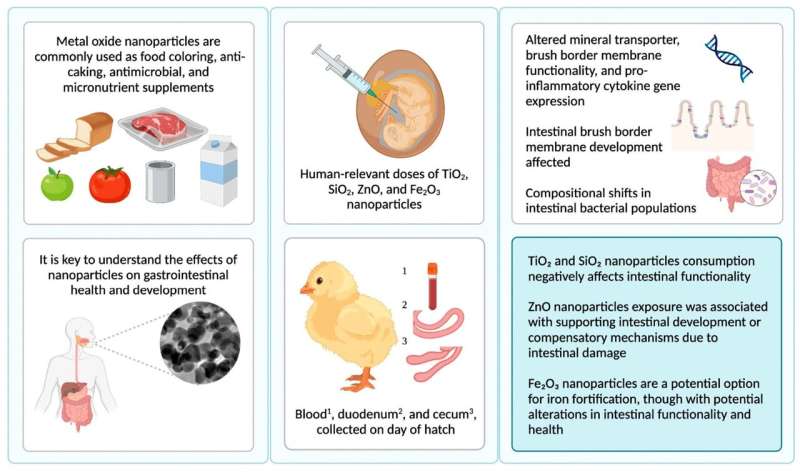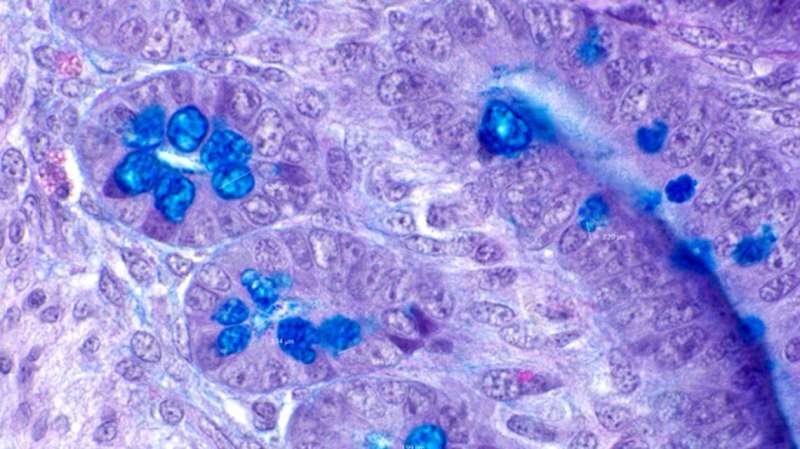This article has been reviewed according to Science X's editorial process and policies. Editors have highlighted the following attributes while ensuring the content's credibility:
fact-checked
peer-reviewed publication
trusted source
proofread
Food coloring and anti-caking nanoparticles may affect the human gut

Metal oxide nanoparticles—ubiquitous in nature, and commonly used as food coloring and anti-caking agents in the commercial ingredients industry—may damage and disturb parts of the human intestine, according to new research conducted by Cornell and Binghamton University scientists.
Their work was published Feb. 9 in the journal Antioxidants.
"We found that specific nanoparticles—titanium dioxide and silicon dioxide—ordinarily used in food may negatively affect intestinal functionality," said senior author Elad Tako, associate professor of food science in the College of Agriculture and Life Sciences. "They have a negative effect on key digestive and absorptive proteins."
In their research, the group used human-relevant doses of titanium dioxide and silicon dioxide in the Tako laboratory's in vivo system, which offers a health response similar to the human body's.
The scientists injected the nanoparticles into chicken eggs. After the chickens hatched, the scientists detected changes in the functional, morphological and microbial biomarkers in the blood, the duodenum (upper intestine) and the cecum (a pouch connected to the intestine).
The scientists found shifts in the composition of intestinal bacterial populations. The animals' mineral transport was affected and the brush border membrane (the intestine's digestive and absorptive surface) was disturbed.
"We are consuming these nanoparticles on a daily basis," said Tako, a faculty fellow in the Cornell Atkinson Center for Sustainability. "We don't really know how much we consume; we don't really know the long-term effects of this consumption. Here, we were able to demonstrate some of these effects, which is a key to understanding gastrointestinal health and development."

Additionally, the group examined zinc oxide, a micronutrient, and iron oxide, an iron fortification supplement. Zinc oxide nanoparticles support intestinal development, as well as a compensatory mechanism following intestinal damage. Iron oxide nanoparticles are a potential option for iron fortification, though with potential alterations in intestinal functionality and health.
Previously, the Binghamton scientists had conducted in vitro cellular assessments and screened different nanoparticles commonly used in the food and pharmaceutical industries. The group narrowed their research to specific metal oxide nanoparticles and ensured testing dosages appropriate for humans.
"Between our two universities, our research used a nice set of systems that complement each other," said Gretchen Mahler, professor of biomedical engineering at Binghamton and interim vice provost and dean of the graduate school.
"We used our in vitro gut models of the small intestine to conduct assays and screen nanoparticle dosages," Mahler said. "We then can validate what we observed in vitro by using Elad Tako's animal model."
The scientists are not advocating for ending the use of these nanoparticles.
"Based on the information, we suggest simply being aware," Tako said. "Science needs to conduct further investigations based on our findings. We are opening the door for discussion."
In addition to Tako and Mahler, co-authors included Cornell doctoral candidates Jacquelyn Cheng (first author) and Nikolai Kolba; Binghamton postdoctoral fellow Alba García-Rodríguez; and Cláudia Marques, associate professor of biological sciences at Binghamton.
The research is part of the journal's special issue on dietary supplements and oxidative stress.
More information: Jacquelyn Cheng et al, Food-Grade Metal Oxide Nanoparticles Exposure Alters Intestinal Microbial Populations, Brush Border Membrane Functionality and Morphology, In Vivo (Gallus gallus), Antioxidants (2023). DOI: 10.3390/antiox12020431
Journal information: Antioxidants
Provided by Cornell University





















